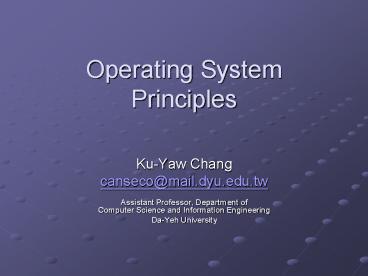Operating System Principles PowerPoint PPT Presentation
1 / 28
Title: Operating System Principles
1
Operating System Principles
- Ku-Yaw Chang
- canseco_at_mail.dyu.edu.tw
- Assistant Professor, Department of Computer
Science and Information Engineering - Da-Yeh University
2
Chapter 4Multithreaded Programming
- A process
- With a single thread of control
- With multiple threads of control
- Multithreaded computer systems
- Pthreads
- Windows 32 threads
- Java thread libraries
- Windows XP and Linux
- Support at the kernel level
3
Chapter 4Multithreaded Programming
- Overview
- Multithreading Models
- Thread Libraries
- Threading Issues
- Operating-System Examples
- Summary
- Exercises
4
4.1 Overview
- A thread
- A basic unit of CPU utilization
- A thread ID
- A program counter
- A register set
- A stack
- Called a lightweight process (LWP)
- A traditional process has a single thread of
control, called a heavyweight process (HWP)
5
Single-threaded and Multithreaded processes
6
4.1.1 Motivation
- A web browser
- One thread display images or text
- Another thread retrieves data from the network
- A word processor
- One thread for displaying graphics
- Another thread for reading keystrokes
- Third thread for performing spelling and grammar
checking
7
4.1.1 Motivation
- If new process will perform the same tasks as the
existing process, why incur all that overhead? - Process creation is very time-consuming and
resource intensive. - Have the server run as a single process that
accepts requests.
8
4.1.2 Benefits
- Responsiveness
- Allow a program to continue even if part of it is
blocked or is performing a lengthy operation - Resource sharing
- Memory
- Different threads all within the same address
space - Resources
- Economy
- More economical to create and context switch
threads - Utilization of multiprocessor architectures
- Increase concurrency
9
Chapter 4Multithreaded Programming
- Overview
- Multithreading Models
- Thread Libraries
- Threading Issues
- Operating-System Examples
- Summary
- Exercises
10
4.2 Multithreading Models
- User threads
- Implemented by a thread library at the user level
- Supported above the kernel
- Advantage
- Fast to create and manage
- Disadvantage
- A thread may cause the entire process to block
- Examples
- POSIX Pthreads
- Win32 threads
- Java threads
11
4.2 Multithreading Models
- Kernel threads
- The kernel performs thread creation, scheduling,
and management - Supported directly by OS
- Advantage
- Kernel can schedule another thread when a thread
is blocked - Disadvantage
- Slow to create and manage
- Examples
- Windows XP
- Linux
- Max OS X
- Solaris
- Tru64 Unix
12
4.2 Multithreading Models
- Many systems provide support for both user and
kernel threads - Different multithreading models
- Many-to-one model
- One-to-one model
- Many-to-many model
13
4.2.1 Many-to-One Model
- Many user-level threads mapped to one kernel
thread
14
4.2.1 Many-to-One Model
- Advantage
- Efficient
- Disadvantage
- Entire process may block if a thread makes a
blocking system call - Unable to run in parallel on multiprocessors
- Used on systems that do not support kernel
threads - Green threads a thread library available for
Solaris - GNU Portable Threads
15
4.2.2 One-to-One Model
- Each user thread mapped to one kernel thread
16
4.2.2 One-to-One Model
- Advantage
- More concurrency
- Disadvantage
- Overhead of creating kernel threads can burden
the performance of an application - Restrict the number of threads
- Example
- Linux
- Windows operating systems
- Windows 95, 98, NT, 2000, and XP
17
4.2.3 Many-to-Many Model
- Multiplex many user-level threads to a small or
equal number of kernel threads two-level model
18
4.2.3 Many-to-Many Model
- Advantage
- Developers can create as many as user threads as
wish - More concurrency
- Example
- IRIX
- HP-UX
- Tru64 Unix
- Solaris prior to version 9
19
Chapter 4Multithreaded Programming
- Overview
- Multithreading Models
- Thread Libraries
- Threading Issues
- Operating-System Examples
- Summary
- Exercises
20
4.3 Thread Libraries
- A thread library
- Provide the programmer an API for creating and
managing threads - Two primary approaches
- A user-level library
- Entirely in user space, with no kernel support
- A local function call in user space
- A kernel-level library
- Supported by the operating system
- A system call to the kernel
21
4.3 Thread Libraries
- Three main thread libraries in use
- POSIX Pthreads
- A specification for thread behavior
- not an implementation
- Win32
- Java
22
Chapter 4Multithreaded Programming
- Overview
- Multithreading Models
- Thread Libraries
- Threading Issues
- Operating-System Examples
- Summary
- Exercises
23
- Be skipped
24
Chapter 4Multithreaded Programming
- Overview
- Multithreading Models
- Thread Libraries
- Threading Issues
- Operating-System Examples
- Summary
- Exercises
25
Summary
- P.141 to P.142
26
Chapter 4Multithreaded Programming
- Overview
- Multithreading Models
- Thread Libraries
- Threading Issues
- Operating-System Examples
- Summary
- Exercises
27
Exercises
- 4.3
- 4.4
28
The End

